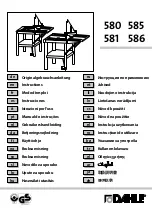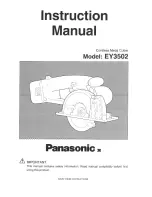
9
Translation of the Original Instruction Manual
Fig. 1
1 Quick action hammer chuck
2 Guide chuck
3 Switch right-left
4 Foot switch
5 Emergency stop switch
6 Motor overload trip
7 Tool holder
8 Pressing lever
9 Handle
10 Clamping ring with wing nut
11 Wing screw
12 Die head
13 Length stop
14 Closing and opening lever
15 Clamping lever
16 Adjusting disk
17 Die holder
18 Pipe cutter
19 Deburrer
20 Oil tray
21 Chip tray
22 Clamping ring
23 Chuck jaw carrier
24 Chuck jaws
25 Screw plug
General Power Tool Safety Warnings
WARNING
Read all the safety notes, instructions, illustrations and technical data which
come with this power tool. Failure to heed the following instructions can lead to
electric shock, fire and/or severe injuries.
Keep all safety notes and instructions for the future.
The term "power tool" used in the safety notes refers to mains operated power tools
(with power cable).
1) Work area safety
a) Keep work area clean and well lit. Cluttered or dark areas invite accidents.
b) Do not operate power tools in explosive atmospheres, such as in the pres-
ence of flammable liquids, gases or dust. Power tools create sparks which
may ignite the dust or fumes.
c) Keep children and bystanders away while operating a power tool. Distrac-
tions can cause you to lose control.
2) Electrical safety
a) Power tool plugs must match the outlet. Never modify the plug in any way.
Do not use any adapter plugs with earthed (grounded) power tools. Unmod-
ified plugs and matching outlets will reduce risk of electric shock.
b) Avoid body contact with earthed or grounded surfaces, such as pipes,
radiators, ranges and refrigerators. There is an increased risk of electric shock
if your body is earthed or grounded.
c) Do not expose power tools to rain or wet conditions. Water entering a power
tool will increase the risk of electric shock.
d) Do not misuse the connecting cable to carry or hang up the power tool or
to pull the plug out of the socket. Keep the connecting cable away from
heat, oil, sharp edges or moving tool parts. Damaged or knotted cables
increase the risk of electric shock.
e) When operating a power tool outdoors, use an extension cord suitable for
outdoor use. Use of a cord suitable for outdoor use reduces the risk of electric
shock.
f) If operating a power tool in a damp location is unavoidable, use a residual
current device (RCD) protected supply. Use of an RCD reduces the risk of
electric shock.
3) Personal safety
a) Stay alert, watch what you are doing and use common sense when operating
a power tool. Do not use a power tool while you are tired or under the influ-
ence of drugs, alcohol or medication. A moment of inattention while operating
power tools may result in serious personal injury.
b) Use personal protective equipment. Always wear eye protection. Protective
equipment such as dust mask, non-skid safety shoes, hard hat, or hearing protec-
tion used for appropriate conditions will reduce personal injuries.
c) Prevent unintentional starting. Ensure the switch is in the off-position before
connecting to power source, picking up or carrying the tool. Carrying power
tools with your finger on the switch or energising power tools that have the switch
on invites accidents.
d) Remove any adjusting key or wrench before turning the power tool on. A
wrench or a key left attached to a rotating part of the power tool may result in
personal injury.
e) Do not overreach. Keep proper footing and balance at all times. This enables
better control of the power tool in unexpected situations.
f) Dress properly. Do not wear loose clothing or jewellery. Keep your hair,
clothing and gloves away from moving parts. Loose clothes, jewellery or long
hair can be caught in moving parts.
g) If devices are provided for the connection of dust extraction and collection
facilities, ensure these are connected and properly used. Use of these devices
can reduce dust related hazards.
h) Do not take your safety for granted and ignore the safety rules for power
tools even if you are very familiar with the power tool after frequent use.
Careless handling can lead to severe injury within split seconds.
4) Power tool use and care
a) Do not force the power tool. Use the correct power tool for your application.
The correct power tool will do the job better and safer at the rate for which it was
designed.
b) Do not use the power tool if the switch does not turn it on and off. Any power
tool that cannot be controlled with the switch is dangerous and must be repaired.
c) Disconnect the plug from the power source before making any adjustments,
changing accessories, or storing power tools. Such preventive safety meas-
ures reduce the risk of starting the power tool accidentally.
d) Store idle power tools out of the reach of children and do not allow persons
unfamiliar with the power tool or these instructions to operate the power
tool. Power tools are dangerous in the hands of untrained users.
e) Look after the power tools and accessories carefully. Check for misalign-
ment or binding of moving parts, breakage of parts and any other condition
that may affect the power tool’s operation. If damaged, have the power tool
repaired before use. Many accidents are caused by poorly maintained power
tools.
f) Keep cutting tools sharp and clean. Properly maintained cutting tools with
sharp cutting edges are less likely to bind and are easier to control.
g) Use power tools, accessories and insert tools etc. according to these
instructions. Take the working conditions and activity being performed into
consideration. The use of power tools for purposes for which they are not intended
can lead to dangerous situations.
h) Keep handles and gripping surfaces dry, clean and free from oil and grease.
Slippery handles and gripping surfaces prevent safe handling and control of the
power tool in unforeseeable situations.
5) Service
a) Have your power tool serviced by a qualified repair person using only
identical replacement parts. This will ensure that the safety of the power tool
is maintained.
Threading Machine Safety Warnings
WARNING
Read all the safety notes, instructions, illustrations and technical data which
come with this power tool. Failure to heed the following instructions can lead to
electric shock, fire and/or severe injuries.
Keep all safety notes and instructions for the future.
Work area safety
●
Keep floor dry and free of slippery materials such as oil. Slippery floors invite
accidents.
●
Restrict access or barricade the area when work piece extends beyond
machine to provide a minimum of one metre clearance from the work piece.
Restricting access or barricading the work area around the work piece will reduce
the risk of entanglement.
Electrical safety
●
Keep all electrical connections dry and away from the floor. Do not touch
plugs or the machine with wet hands. These safety precautions reduce the
risk of electric shock.
Personal safety
●
Do not wear gloves or loose clothing when operating machine. Keep sleeves
and jackets buttoned. Do not reach across the machine or pipe. Clothing
can be caught by the pipe or machine resulting in entanglement.
Machine safety
●
Do not use the machine if it is damaged. There is a danger of accident.
●
Follow instructions on proper use of this machine. Do not use for other
purposes such as drilling holes or turning winches. Other uses or modifying
this power drive for other applications may increase the risk of serious injury.
●
Secure machine to bench or stand. Support long heavy pipe with pipe
supports. This practice will prevent machine tipping.
●
While operating the machine, stand on the side where the FORWARD/
REVERSE switch is located. Operating the machine from this side eliminates
the need to reach over the machine.
●
Keep hands away from rotating pipes or fittings. Switch off the machine
before cleaning pipe threads or screwing on fittings. Let the machine come
to a complete standstill before touching the pipe. This procedure reduces
the possibility of getting trapped by rotating parts.
●
Do not use the machine for screwing on or unscrewing fittings; it is not
intended for this purpose. Such use could lead to trapping, entanglement and
loss of control.
●
Keep covers in place. Do not operate the machine with covers removed.
Exposing moving parts increases the probability of entanglement.
Footswitch safety
●
Do not use this machine if the footswitch is broken or missing. Footswitch
is a safety device that provides better control by letting you shut off the motor in
various emergency situations by removing your foot from the switch. For example:
if clothing should become caught in the machine, the high torque will continue
pulling you into the machine. The clothing itself can bind around your arm or
other body parts with enough force to crush or break bones.
Additional Safety Instructions for Thread Cutting Machines
●
Only connect the machine of protection class I to a socket/extension lead
with a functioning protective contact. There is a danger of electric shock.
●
Check the power cable of the machine and extension leads regularly for
damage. Have these renewed by qualified experts or an authorised ROLLER
customer service workshop in case of damage.
eng eng
eng Instruction Manual










































